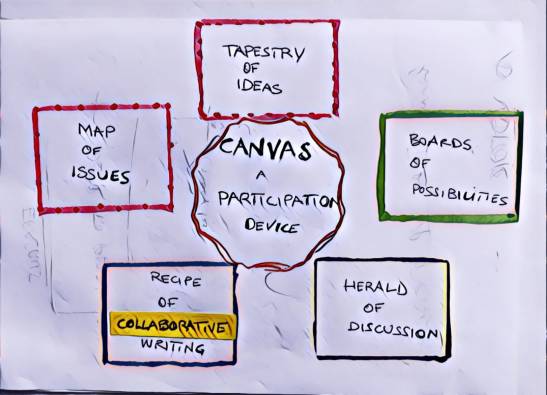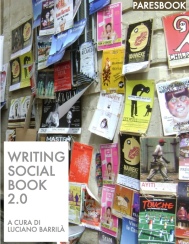Canvas: a participation device
A canvas, or to put it better “canvases”, are resources to help groups (and individuals) to think and to build up shared sense. I’ll try to explain why from my perspective.
What is a canvas?
In its materiality, a canvas is a pre-prepared poster, large enough to be put on a wall and read by everyone who is in the room (roughly 100×70 cm). It shows the issues to be discussed and provides space both for questions and contributions. A canvas is an oriented map, open and ready to be enriched by more information, ideas, and thoughts.
Why a canvas is an engaging tool?
On the web you can find many canvases, built for different, sometimes focused, purposes. They have some common aspects.
- Static and dynamic. Canvas is a static object, made of paper, printed or drawn. But, like a manifesto, it leads to reading it and thinking of it. If you leave and return in the room, it is still there, with its main questions and its sub-questions, with the topics it poses to the bystander. A canvas also is a dynamic object. In two ways. First, it is designed to write on it (or better to attach some post-it on it). Second, it can be moved around, put on a flip board, on the table, in a different room to be used to facilitate meetings.
- Visual and practical. A canvas offers, at a glance, a synoptic view. The most important elements you have to consider, to investigate, to discuss are there: it is not difficult to identify them and to anticipate the connections. But a canvas is also a practical device: in front of you, there are many spaces to fill in. The titles of each space (with their evocative words or questions) attract your attention. In a group, you can be asked to work on the main topic (the title of the canvas) or on the subdomain. At the end of a working session, many ideas have been gathered, and are there to be reconsidered.
- Definite and extendible. A canvas offers a set of challenges to all the participants of the working group: the game is fair, the assignment is there, the task is definite. And yet, it is possible to think out of the box: you can explore uncharted territories, with new questions, widening the perimeter, or finding an emergent theme you can improve the issue to be considered.
- Harbinger of involvement. When you open a canvas (and of course when you propose to build up one) you express strong intentionality to share relevant topics to be collectively considered. It does not pose an ultimate statement, it does not spread an agreed synthesis. A canvas call to express ideas and proposals as a result of dialogue.
- Pattern and format. A canvas brings some hypotheses about issues that matter and their relationship (not already defined but at least assumed), so it channels the users’ attention on specific fields. The structure, made by boards arranged side by side, offers a vision. But a canvas with “what” deals also with “how”. It offers ingredients and a kind of “elaborative recipe” to produce some collective thoughts. So a canvas is an intentional pattern-generating and collective sensemaking format, bringing a structured configuration of questions. At the same time, it is a format that invites and activates collective engagement and elaboration around the underlying scheme.
Canvases are manifesto-charts, they pose issues, they draw maps for thought, to write (do not forget the power of post-it, despite oversaturation), and to connect ideas. In conclusion, if you have any matter to gather people on, to go deep, and to examine it, you should consider preparing a targeted canvas to facilitate participation and to make it productive.
Thanks to Charles Blass (@lovevolv) for the suggestions.
Rilancia
- Click to email a link to a friend (Opens in new window)
- Click to print (Opens in new window)
- Click to share on Twitter (Opens in new window)
- Click to share on Facebook (Opens in new window)
- Click to share on Telegram (Opens in new window)
- Click to share on WhatsApp (Opens in new window)
- Click to share on LinkedIn (Opens in new window)
- Click to share on Tumblr (Opens in new window)
Related
Information
This entry was posted on 21 August 2020 by Mainograz in Connettere, coordinare, collaborare, cooperare, La fatica di scrivere, Psicosociologia, Se scrivere è organizzare... and tagged #MetaCAugs, Canvas, Engagement tools, Participation, Participation techniques, Writing lab.Shortlink
https://wp.me/pKDlg-2hiNavigation
Chi cerca trova
Post recenti
- Canvas: a participation device
- If you are not aware you can’t appreciate it
- Five good reasons to write
- Tact/ics to fluidify online meetings
- Cinque competenze organizzative per il presente e il futuro prossimo (versione 1)
- Radar: uno strumento per mettere in connessione presente e futuro prossimo
- Come lavorare e collaborare online? Una rapida mappa di possibili format
- The 4 Ps of webinars – prepare, propose, promote and post-produce
- Come usare WhatsApp senza fare/farsi male!
- Promuovere iniziative online
- Ventidue suggerimenti per scrivere in coppia online
- Stimatissime/i prof,
- Un gruppo di lettura online?
- Gruppi di lettura online: da un web-lab sperimentale abbiamo capito questo
- Webinar 4P – preparare, proporre, promuovere e post-produrre
Comunicare 2.0
Non tutto è lavoro
Strumenti di ricerca
Argomenti
- 231 (7)
- Avvicendamenti e continuità d'impresa (46)
- collaborare (27)
- Connettere (20)
- Connettere, coordinare, collaborare, cooperare (68)
- cooperare (21)
- coordinare (10)
- coordinare (1)
- coordinare (2)
- coordinare (1)
- coordinare (1)
- coordinare (1)
- Eventi (3)
- Generale (214)
- Organizzare (95)
- Bilancio sociale (24)
- Qualità (17)
- Ospiti (51)
- Partnership (32)
- Per affrontare cambiamenti e innovazioni (81)
- Psicosociologia (152)
- Quanto basta (94)
- Responsabilità in pratica (41)
- Scrittura (3)
- Se scrivere è organizzare… (166)
- Decaloghi (8)
- La fatica di scrivere (31)
- Scrivere 2.0 (48)
Archives
- August 2020 (4)
- May 2020 (1)
- April 2020 (4)
- March 2020 (6)
- December 2019 (1)
- August 2019 (1)
- March 2019 (1)
- December 2018 (1)
- November 2018 (2)
- October 2018 (1)
- July 2018 (3)
- June 2018 (1)
- April 2018 (1)
- March 2018 (1)
- February 2018 (1)
- December 2017 (3)
- November 2017 (3)
- October 2017 (3)
- May 2017 (4)
- April 2017 (6)
- March 2017 (9)
- February 2017 (2)
- January 2017 (4)
- December 2016 (2)
- November 2016 (4)
- September 2016 (2)
- August 2016 (3)
- July 2016 (4)
- June 2016 (4)
- May 2016 (3)
- March 2016 (2)
- February 2016 (2)
- January 2016 (5)
- December 2015 (5)
- November 2015 (2)
- October 2015 (2)
- September 2015 (2)
- August 2015 (1)
- July 2015 (3)
- June 2015 (4)
- May 2015 (6)
- April 2015 (5)
- March 2015 (9)
- February 2015 (4)
- January 2015 (5)
- December 2014 (6)
- November 2014 (4)
- October 2014 (4)
- September 2014 (1)
- August 2014 (5)
- July 2014 (7)
- June 2014 (9)
- May 2014 (9)
- April 2014 (7)
- March 2014 (9)
- February 2014 (3)
- January 2014 (2)
- December 2013 (6)
- November 2013 (5)
- October 2013 (11)
- September 2013 (6)
- August 2013 (5)
- July 2013 (2)
- June 2013 (6)
- May 2013 (7)
- April 2013 (4)
- March 2013 (16)
- February 2013 (11)
- January 2013 (9)
- December 2012 (6)
- November 2012 (10)
- October 2012 (9)
- September 2012 (13)
- August 2012 (4)
- July 2012 (4)
- June 2012 (9)
- May 2012 (9)
- April 2012 (9)
- March 2012 (7)
- February 2012 (11)
- January 2012 (7)
- December 2011 (14)
- November 2011 (16)
- October 2011 (13)
- September 2011 (14)
- August 2011 (9)
- July 2011 (9)
- June 2011 (5)
- May 2011 (12)
- April 2011 (9)
- March 2011 (7)
- February 2011 (8)
- January 2011 (10)
- December 2010 (14)
- November 2010 (9)
- October 2010 (13)
- September 2010 (11)
- August 2010 (5)
- July 2010 (9)
- June 2010 (16)
- May 2010 (28)
- April 2010 (37)
- March 2010 (11)
- January 2010 (7)
- December 2009 (3)
Più cliccati
Pages
Post più letti
- Genitori in fase di separazione conflittuale e delega a terze persone a ritirare i figli [#231]
- L’uso del condizionale come formula di cortesia
- Quando grazie (non) vuol dire grazie (#prendifiatolab)
- L'importanza della nota metodologica
- Amministrazione di sostegno: una breve scheda sulla legge 6/2004
- Una (piccolissima) missione da compiere (e un sondaggio)...
- Sette modi per corrompere (#231)
- Come scrivere un abstract (#prendifiatolab)
- PS… al tempo delle email, dei post e degli sms (scrivere email senza far/si male;-)
- Test di verifica dell’apprendimento: inutili supplizi o…
Comunicare 2.0
Non tutto è lavoro
Strumenti di ricerca
Comunicare 2.0
Non tutto è lavoro
Comunicare 2.0
Non tutto è lavoro
Chi cerca trova
Archives
- August 2020 (4)
- May 2020 (1)
- April 2020 (4)
- March 2020 (6)
- December 2019 (1)
- August 2019 (1)
- March 2019 (1)
- December 2018 (1)
- November 2018 (2)
- October 2018 (1)
- July 2018 (3)
- June 2018 (1)
- April 2018 (1)
- March 2018 (1)
- February 2018 (1)
- December 2017 (3)
- November 2017 (3)
- October 2017 (3)
- May 2017 (4)
- April 2017 (6)
- March 2017 (9)
- February 2017 (2)
- January 2017 (4)
- December 2016 (2)
- November 2016 (4)
- September 2016 (2)
- August 2016 (3)
- July 2016 (4)
- June 2016 (4)
- May 2016 (3)
- March 2016 (2)
- February 2016 (2)
- January 2016 (5)
- December 2015 (5)
- November 2015 (2)
- October 2015 (2)
- September 2015 (2)
- August 2015 (1)
- July 2015 (3)
- June 2015 (4)
- May 2015 (6)
- April 2015 (5)
- March 2015 (9)
- February 2015 (4)
- January 2015 (5)
- December 2014 (6)
- November 2014 (4)
- October 2014 (4)
- September 2014 (1)
- August 2014 (5)
- July 2014 (7)
- June 2014 (9)
- May 2014 (9)
- April 2014 (7)
- March 2014 (9)
- February 2014 (3)
- January 2014 (2)
- December 2013 (6)
- November 2013 (5)
- October 2013 (11)
- September 2013 (6)
- August 2013 (5)
- July 2013 (2)
- June 2013 (6)
- May 2013 (7)
- April 2013 (4)
- March 2013 (16)
- February 2013 (11)
- January 2013 (9)
- December 2012 (6)
- November 2012 (10)
- October 2012 (9)
- September 2012 (13)
- August 2012 (4)
- July 2012 (4)
- June 2012 (9)
- May 2012 (9)
- April 2012 (9)
- March 2012 (7)
- February 2012 (11)
- January 2012 (7)
- December 2011 (14)
- November 2011 (16)
- October 2011 (13)
- September 2011 (14)
- August 2011 (9)
- July 2011 (9)
- June 2011 (5)
- May 2011 (12)
- April 2011 (9)
- March 2011 (7)
- February 2011 (8)
- January 2011 (10)
- December 2010 (14)
- November 2010 (9)
- October 2010 (13)
- September 2010 (11)
- August 2010 (5)
- July 2010 (9)
- June 2010 (16)
- May 2010 (28)
- April 2010 (37)
- March 2010 (11)
- January 2010 (7)
- December 2009 (3)
Mainograz
Mainograz non raccoglie cookies di profilazione
Mainograz è il blog professionale di Graziano Maino, consulente di organizzazioni e network, professionista indipendente (legge 4/2013).
Scopo di questo blog è esprimere il mio punto di vista su questioni che reputo interessanti e discuterne con chi ha piacere di farlo.
Non raccolgo informazioni di profilazione sulle persone che visitano il blog Mainograz.
Tutte le statistiche sulla fruizione del blog Mainograz (ad esempio sulle pagine visitate e sugli argomenti ricercati) mi vengono fornite in forma anonima e aggregata da Wordpress.com.
Anche i commenti possono essere espressi senza dichiarare la propria identità. Mi riservo solo di verificare il contenuto del primo commento, che se accolto, consente poi di commentare liberamente.
Visitors
- 535,111 visite da dicembre 2009









Recent Comments